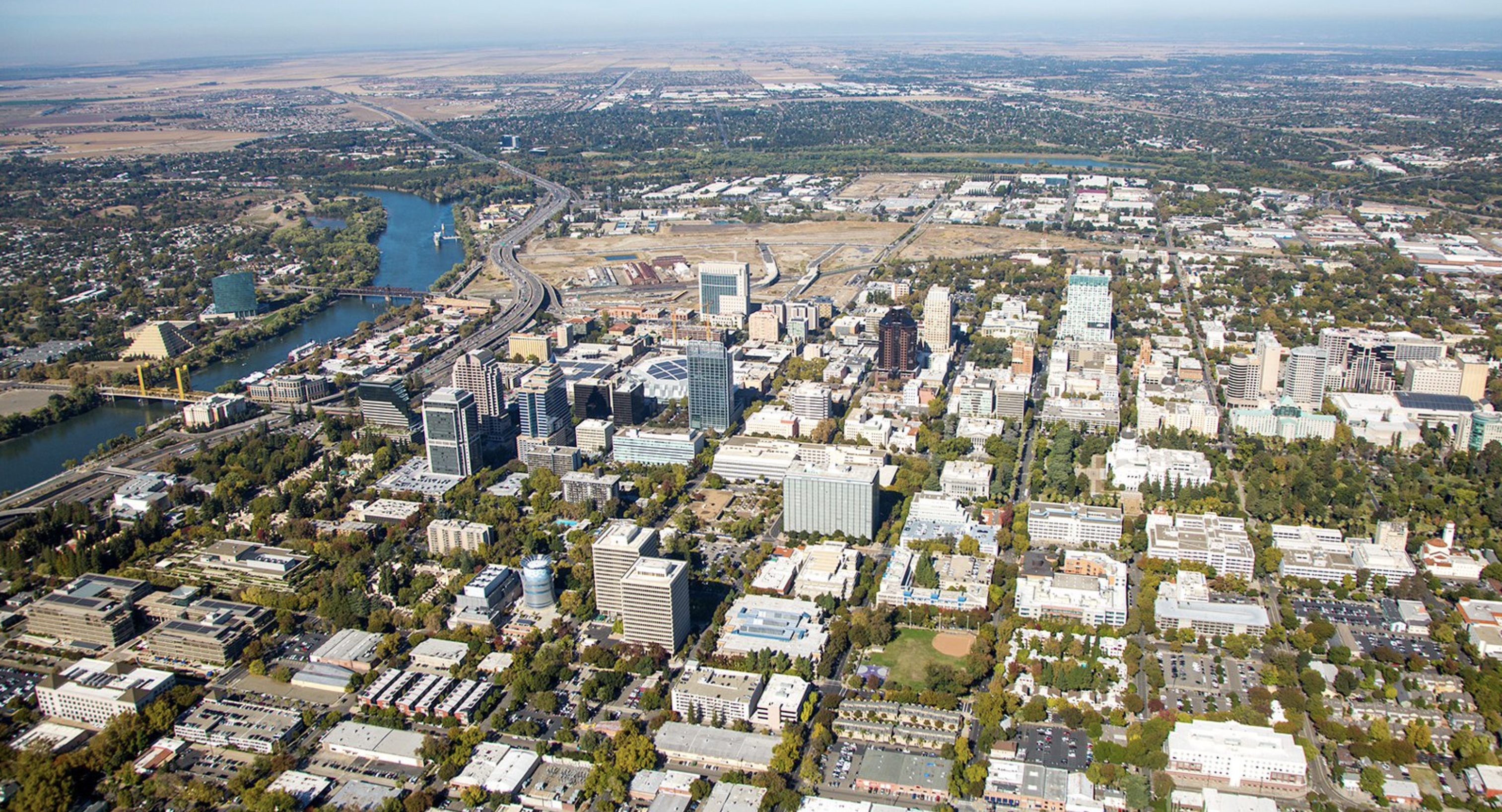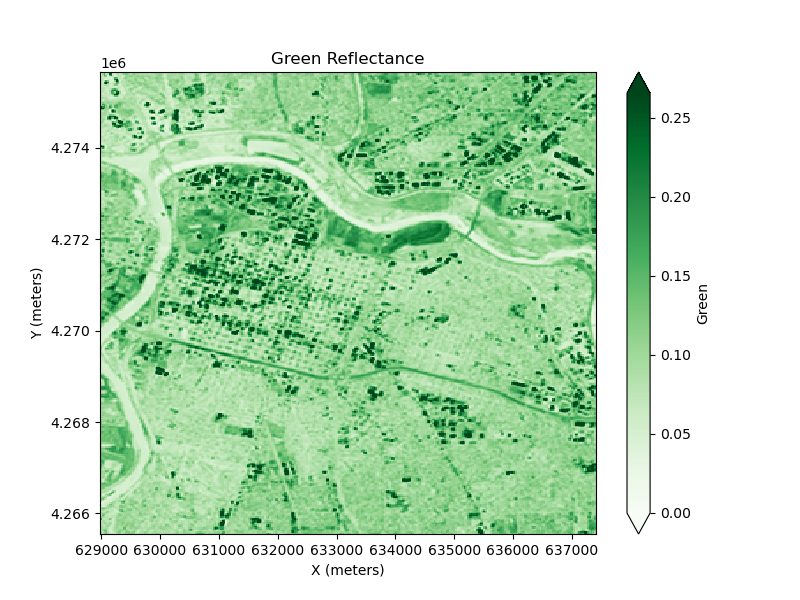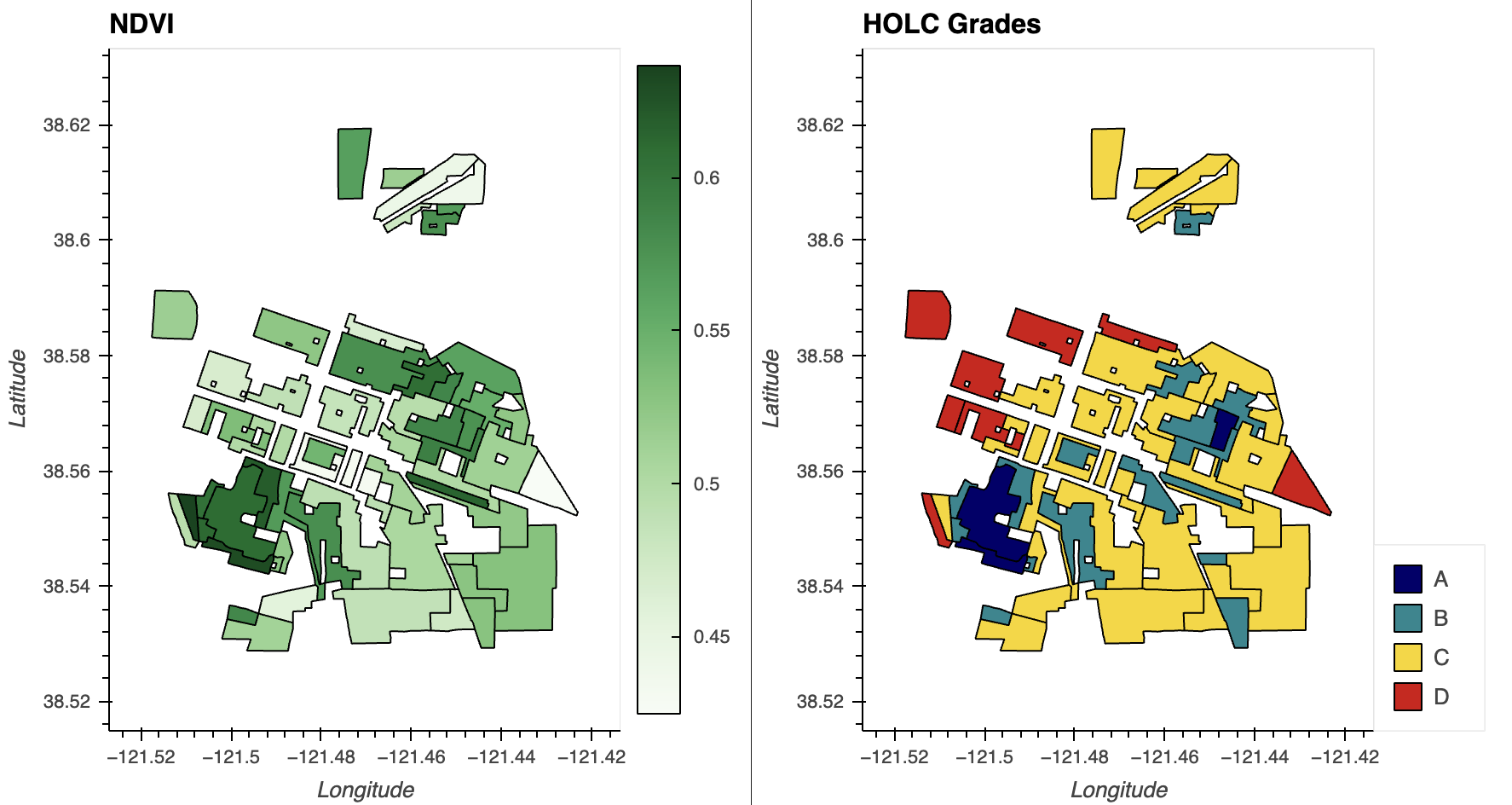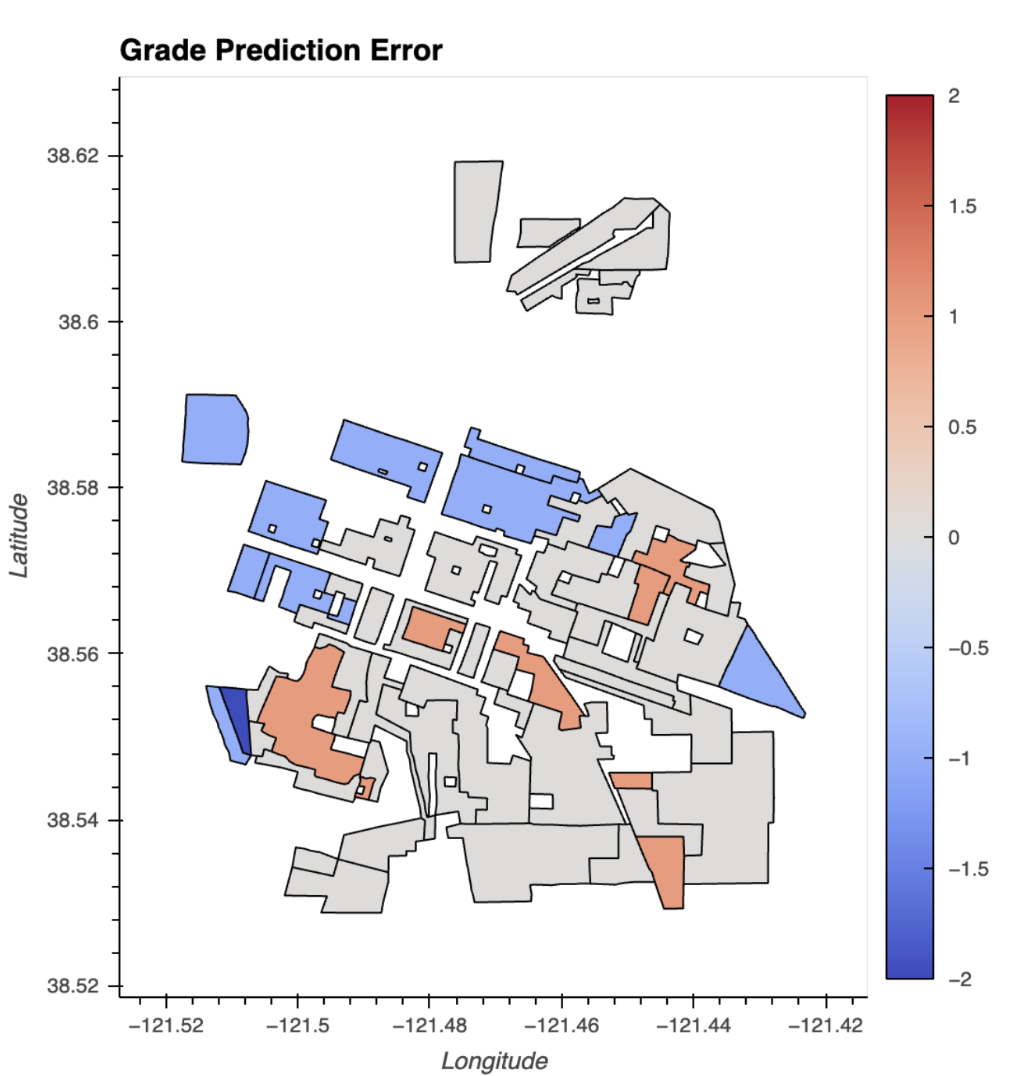Sacramento Redlining
Greenspace Analysis

Introduction
During the mid-late 1930s in the United States, redlining maps proliferated and became common practice in lending decisions until the 1968 Fair Housing Act formally banned explicit racial discrimination in mortgage lending (Michney, n.d.). The best preserved maps of that era are the Home Owners’ Loan Corporation (HOLC) security maps created through its City Survey from 1935 to 1940. HOLC was established through the New Deal to support homeowners in the decimated housing market. The HOLC Mortgage Rehabilitation Department (MRD) aimed to meet that objective while minimizing an additional bailout of underwater mortgages. Field agents surveyed municipalities with populations over 40,000, 239 cities in total including Sacramento, California, and assembled reports on the health of a city’s real estate market.
HOLC surveys equated the physical characteristics of a built environment with the racial and economic attributes of building residents. Physical deterioration was perceived as a sign of demographic change. The HOLC rating system distinguished neighborhoods by grade and color: A or green areas consisted of new buildings and wealthy, white residents; B or blue areas may have incorporated Jewish residents and were “still desirable”; C or yellow areas were described as in decline; and D or red areas had already “declined” and been deemed hazardous for lending, with even a single Black resident relegating a neighborhood to this grade (Zimring, 2015). These maps enabled HOLC and the Federal Housing Authority to issue insured mortgages to white people living in homogenous developments of new, clean homes. Racial segregation was amplified further in the 20th century with waste handling businesses clustered in non-white residential areas and spatial environmental inequalities emerging by 1960.
Data Description
The HLSL30 v002 product provides 30-m Nadir Bidirectional Reflectance Distribution Function (BRDF)-Adjusted Reflectance (NBAR) and is derived from Landsat 8/9 Operational Land Imager (OLI) data products through the Harmonized Landsat Sentinel-2 (HLS) project. The sensor resolution is 30m, imagery resolution is 30m, and the temporal resolution is daily with an 8 day revisit time.
The Sacramento subset of the Mapping Inequality dataset is derived from City Survey Files, 1935-1940 at the National Archives. The data contains redlining maps and reports of economic health and mortgage lending risk by location.
Data Citation
Madron, J., Champine, R., Dzuliashvili, Z., Encino, R., Holland, J., Jones, K., … Kliebert, P. (2023). Mapping inequality: Redlining in New Deal America (3) [Data set]. University of Richmond. https://dsl.richmond.edu/panorama/redlining/static/mappinginequality.gpkg
NASA. (2024). HLSL30 v002 [Data set]. http://doi.org/10.5067/HLS/HLSL30.002
Methods
The redlining GeoPackage was loaded into a GeoDataFrame with geopandas and subset for the city of Sacramento. earthaccess (a library for NASA’s Search API) retrieved data granules by dataset (HLSL30) and limited the scope to a single day in 2024 and the spatial bounds collected from the redlining GeoDataFrame. Next the landsat data was filtered by band and stored in a pandas DataFrame. Data granules were grouped by tile ID, subset to red, green, and NIR bands, cropped, scaled, masked, and merged before storing the resulting xarray DataArrays in a dictionary indexed by band.
Normalized Difference Vegetation Index (NDVI) was calculated with band DataArrays. The regionmask library created a mask of the HOLC zones from the redlining GeoDataFrame and the longitude and latitude sourced from a band DataArray. Thereafter, NDVI summary statistics were calculated for each zone using the NDVI DataArray and redlining mask with xarray-spatial. Statistics were merged on the zone with the redlining GeoDataFrame and the HOLC grades were ordered for plotting. NDVI and redlining grade were plotted in linked subplots using the hvplot API. A scikit-learn decision tree was then applied to predict HOLC grade by NDVI average and evaluated by k-fold cross-validation. Finally, the grade prediction error by zone was determined and plotted.
Analysis
Import Libraries
import os
import pathlib
import re
import numpy as np
import pandas as pd
import geopandas as gpd
import hvplot.pandas
import matplotlib.pyplot as plt
from sklearn.tree import DecisionTreeClassifier
from sklearn.model_selection import cross_val_score
# Work with raster data
import xarray as xr
import rioxarray as rxr
from rioxarray.merge import merge_arrays
import cartopy.crs as ccrs
import regionmask
from xrspatial import zonal_stats
import earthaccess
Retrieve Redlining Data
# create the project data directory
data_dir = os.path.join(
# Home directory
pathlib.Path.home(),
# Earth analytics data directory
'earth-analytics',
'data',
# Project directory
'redlining',
)
os.makedirs(data_dir, exist_ok=True)
# Define url for redlining download
us_census_redlining_url = (
"https://dsl.richmond.edu/panorama/redlining/static"
"/mappinginequality.gpkg"
)
# Set up a path to save the data locally
redlining_dir = os.path.join(data_dir, 'redlining')
# Make the U.S. Census Survey directory
os.makedirs(redlining_dir, exist_ok=True)
# Join redlining geopackage path
redlining_map_path = os.path.join(redlining_dir, 'redlining.shp')
# Only download once and create GeoDataFrame
if not os.path.exists(redlining_map_path):
redlining_gdf = gpd.read_file(us_census_redlining_url)
redlining_gdf.to_file(redlining_map_path)
# Load from file
redlining_gdf = (
gpd.read_file(redlining_map_path)
)
# Select city data
sacramento_redlining_gdf = redlining_gdf.loc[redlining_gdf['city'] == 'Sacramento']
# Drop rows where column 'grade' is None
grade_gdf= sacramento_redlining_gdf.dropna(subset=['grade'])
# dissolve all the geometries within a given group (city) into a single geometric feature
# plot with EsriImagery basemap
grade_gdf.hvplot(
geo=True, tiles='EsriImagery',
title='HOLC Redlining of Sacramento',
c="grade", line_color='darkgrey', line_width=3,
frame_width=550
)

Process Multispectral Data
earthaccess.login(strategy="interactive", persist=True)
sacramento_results = earthaccess.search_data(
short_name="HLSL30",
bounding_box=tuple(sacramento_redlining_gdf.total_bounds),
temporal=("2024-07-11"),
count=30
)
landsat_data = earthaccess.open(sacramento_results)
def process_image(uri, bounds_gdf):
"""
Load, crop, and scale a raster image from earthaccess
Parameters
----------
uri: file-like or path-like
File accessor downloaded or obtained from earthaccess
bounds_gdf: gpd.GeoDataFrame
Area of interest to crop to
Returns
-------
cropped_da: rxr.DataArray
Processed raster
"""
# load and scale
da = rxr.open_rasterio(uri, mask_and_scale=True).squeeze()
# obtain crs from raster
reflectance_data_crs = da.rio.crs
# match coordinate reference systems
bounds_gdf = bounds_gdf.to_crs(reflectance_data_crs)
# get study bounds da
study_bounds = bounds_gdf.total_bounds
# crop
cropped_da = da.rio.clip_box(
minx=study_bounds[0],
miny=study_bounds[1],
maxx=study_bounds[2],
maxy=study_bounds[3]
)
return cropped_da
def process_cloud_mask(cloud_uri, bits_to_mask):
"""
Load an 8-bit Fmask file and process to a boolean mask
Parameters
----------
uri: file-like or path-like
Fmask file accessor downloaded or obtained from earthaccess
bits_to_mask: list of int
The indices of the bits to mask if set
Returns
-------
cloud_mask: np.array
Cloud mask
"""
cloud_da = rxr.open_rasterio(cloud_uri, mask_and_scale=True).squeeze()
# Get the cloud mask as bits
cloud_bits = (
np.unpackbits(
(
# Get the cloud mask as an array...
cloud_da.values
# ... of 8-bit integers
.astype('uint8')
# With an extra axis to unpack the bits into
[:, :, np.newaxis]
),
# List the least significat bit first to match the user guide
bitorder='little',
# Expand the array in a new dimension
axis=-1)
)
# Add up the bits for each pixel
cloud_mask = np.sum(
# Select bits
cloud_bits[:,:,bits_to_mask],
# Sum along the bit axis
axis=-1
)
# Mask the pixel if the sum is greater than 0
# (If any of the bits are True)
cloud_mask = cloud_mask == 0
return cloud_mask
# Compile a regular expression to search for metadata
# Use () to select the desired name and only output that name
uri_re = re.compile(
r"v2.0/(HLS.L30.*.tif)"
)
# Select unique granules
tile_id_re = re.compile(
r"HLSL30.020/(HLS.L30..*.v2.0)/HLS"
)
# Grab band IDs
band_id_re = re.compile(
r"HLS.L30..*v2.0.(\D{1}.*).tif"
)
# Find all the metadata in the file name
uri_groups = []
for idx, uri in enumerate(landsat_data):
# Make sure uri has full_name property first
if (hasattr(uri, 'full_name')):
file_name = uri_re.findall(uri.full_name)[0]
tile_id = tile_id_re.findall(uri.full_name)[0]
band_id = band_id_re.findall(uri.full_name)[0]
uri_groups.append({
'filename': file_name,
'tile_id': tile_id,
'band_id': band_id,
'uri': uri
})
# Create a DataFrame with the File-like URI
raster_df = pd.DataFrame(data=uri_groups, columns=['filename', 'tile_id', 'band_id', 'uri'])
# Only keep spectral bands and cloud Fmask
exclude_files = ['VAA', 'VZA', 'SAA', 'SZA']
# Select data not in the excluded files list
raster_df = raster_df[~raster_df['band_id'].isin(exclude_files)]
# Check the results
raster_df
# Bands of interest
bands = {
'B02': 'red',
'B03': 'green',
'B05': 'nir'
}
bits_to_mask = [
1, # Cloud
2, # Adjacent to cloud
3, # Cloud shadow
5 # Water (to not confuse with greenspace)
]
# Initialize structure for saving images
sac_das = {band_name: [] for band_name in bands.keys()}
# unique data granules
tile_groups = raster_df.groupby('tile_id')
for tile_name, tile_df in tile_groups:
# Grab Fmask row from tile group
Fmask_row = tile_df.loc[tile_df['band_id'] == 'Fmask']
# Load the cloud mask
cloud_path = Fmask_row.uri.values[0]
cloud_mask = process_cloud_mask(cloud_path, bits_to_mask)
# Load spectral bands
keep_bands = ['B03', 'B02', 'B05']
selected_bands_df = tile_df[tile_df['band_id'].isin(keep_bands)]
band_groups = selected_bands_df.groupby('band_id')
for band_name, band_df in band_groups:
for index, row in band_df.iterrows():
# Process band
cropped_da = process_image(row.uri, sacramento_redlining_gdf)
# Apply mask on band to remove unwanted cloud data
cloud_masked_da = cropped_da.where(~cropped_da.isin(cloud_mask))
# Store the resulting DataArray
sac_das[band_name].append(cloud_masked_da)
sac_das_merged = {}
# Merge all tiles
for band_name, das in sac_das.items():
merged = merge_arrays(das)
sac_das_merged[band_name] = merged
Inspect Reflectance
fig = plt.figure(figsize=(8, 6))
ax = plt.axes()
city_green_plt = sac_das_merged['B03'].plot(cmap='Greens', vmin=0, robust=True, cbar_kwargs={'label': 'Green'})
plt.title('Green Reflectance')
# based on the CRS projection
ax.set_xlabel('X (meters)')
ax.set_ylabel('Y (meters)')
fig.savefig("/assets/img/sac_redlining/city-green-reflectance.png")
city_green_plt

Explore relationship between Normalized Difference Vegetation Index and HOLC grades
# Calculate Normalized Difference Vegetation Index (NDVI)
sac_ndvi = (
(sac_das_merged['B05'].values - sac_das_merged['B02'].values)
/ (sac_das_merged['B05'].values + sac_das_merged['B02'].values)
)
coords= {
'latitude': sac_das_merged['B02'].coords['y'].values,
'longitude': sac_das_merged['B02'].coords['x'].values
}
sac_ndvi_da = xr.DataArray(sac_ndvi, coords)
# Obtain mask for zones
sac_redlining_mask = regionmask.mask_geopandas(
sacramento_redlining_gdf.to_crs(sac_das_merged['B02'].rio.crs),
sac_das_merged['B02'].x, # meters
sac_das_merged['B02'].y, # meters
# The regions do not overlap bc no lat/long coords
overlap=False,
# We're not using geographic coordinates
wrap_lon=False
)
# Calculate NDVI stats for each redlining zone
sac_ndvi_stats = zonal_stats(zones=sac_redlining_mask, values=sac_ndvi_da)
# Merge stats on the zone
# zone is on the index
sacramento_redlining_gdf.index
# Merge the NDVI stats with redlining geometry into one `GeoDataFrame` on zone index
sac_ndvi_gdf = sacramento_redlining_gdf.merge(sac_ndvi_stats.set_index('zone'), left_index=True, right_index=True)
# Change grade to ordered Categorical for plotting
sac_ndvi_gdf.grade = pd.Categorical(
sac_ndvi_gdf.grade,
ordered=True, # the grades are ordered
categories=['A', 'B', 'C', 'D']
)
# Drop rows with NA grades
sac_ndvi_gdf = sac_ndvi_gdf.dropna(subset=["grade"])
# Plot NDVI and redlining grade in linked subplots
(
sac_ndvi_gdf.hvplot(
title='NDVI',
c='mean',
geo=True,
cmap='Greens',
frame_width=300,
frame_height=400
)
+
sac_ndvi_gdf.hvplot(
title='HOLC Grades',
c='grade',
geo=True,
cmap='cet_rainbow4',
frame_width=300,
frame_height=400
)
)

# Convert categories to numbers
sac_ndvi_gdf['grade_codes'] = sac_ndvi_gdf.grade.cat.codes
# Fit model
tree_classifier = DecisionTreeClassifier(max_depth=2).fit(
sac_ndvi_gdf[['mean']], # predict with ndvi mean
sac_ndvi_gdf['grade_codes'] # observed target
)
# Plot results
sac_ndvi_gdf['predictions'] = (
tree_classifier.predict(sac_ndvi_gdf[['mean']])
)
sac_ndvi_gdf['error'] = (
sac_ndvi_gdf['predictions'] -
sac_ndvi_gdf['grade_codes']
)
sac_ndvi_gdf.hvplot(
title='Grade Prediction Error',
c='error',
geo=True,
frame_width=400,
frame_height=500
)

# Evaluate the model with cross-validation
results = cross_val_score(
DecisionTreeClassifier(max_depth=2),
sac_ndvi_gdf[['mean']],
sac_ndvi_gdf['grade_codes'],
cv=4 # reduce folds because of small dataset
)
print(f'Results: {results}')
Results: [0.57142857 0.42857143 0.64285714 0.42857143]
Discussion
The legacy of redlining has siloed communities of color in areas that are more likely to lack green space and be located closer to environmental hazards (Thomas, 2022). The observed environmental injustices imposed in redlined neighborhoods are extensive with impacts ranging across communities:
- Today, approximately 43% of Black Americans live in urban “heat islands” which contain minimal tree cover and large amounts of exposed asphalt and concrete which retain heat and increase ambient temperature. These neighborhoods are up to 12.6°F warmer than non-redlined neighborhoods. Extreme heat events are also exacerbated in redlined areas, with Black Americans incurring higher rates of heat-related deaths and illnesses than white communities.
- Compared to Latinx Americans, white communities are 21% less likely to live in a heat island. Additionally, over 4.3 million Latinx families live in homes without access to air-conditioning. Air pollution is another great concern: about 50% of Latinx individuals live in areas which violate clean air and ozone standards.
- Urban heat islands magnify impacts of diminished indoor air quality as well which has been attributed to asthma rates in tribal communities that are nearly double the U.S. average. Furthermore, the inequitable distribution of urban green space coincides with other forms of systemic racism and their impacts, such as government displacement of tribal communities and sparse access to safe running water.
- On average, 50% of Asian American communities have reduced access to shaded green spaces and 32% of Asian Americans live in neighborhoods where heat-retaining surfaces cover more than half of the ground. Moreover, Southeast and South Asian communities have the 4th and 5th highest risk of cancer due to air pollution. Compared to other racial groups, Chinese and Korean Americans have the largest mean cancer risk from air pollution exposure.
Robert Bullard, the “father of environmental justice” in the United States, asserted in a 2018 interview that inequity in neighborhoods is not just about proximity to hazards, but also limited access to elements that foster healthy communities: “Communities of color don’t get a fair share of the good stuff – parks, green spaces, nature trails, good schools, farmers markets, good stores. They get less of all the things that make communities healthy and get more of their fair share of the bad stuff.” This is phenomenon is reflected in the HOLC area descriptions. The HOLC security map for Sacramento described one “B” area as a “new subdivision, located in a natural oak grove” with homogenous improvements and population, high class construction, and favorable influences encompassing schools, churches, and trading facilities. On the contrary, “D” areas were described as having detrimental influences such as a heterogeneous population and the absence of building improvements.
We can inspect landsat data for the redlining differences in vegetation (see Green Reflectance plot), however there is not a significant decrease in green radiation until a plant is extremely stressed. A more useful indicator of healthy vegetation is the comparison of Near-InfraRed (NIR) to red reflectance, calculated by the Normalized Difference Vegetation Index (NDVI). For each redlining zone, the NDVI was assessed (see NDVI vs. HOLC Grades plot). A simple decision tree classifier performs fairly well in predicting the HOLC grade based on the mean NDVI. Given the 4 target grades and scores rising well above 25% accuracy, this suggests a moderate to mid-high dependency between NDVI and HOLC grade.
References
Barrett, A., Battisto, C., J. Bourbeau, J., Fisher, M., Kaufman, D., Kennedy, J., … Steiker, A. (2024). earthaccess (Version 0.12.0) [Computer software]. Zenodo. https://doi.org/10.5281/zenodo.8365009
Collins, B., Hetzel, J. T., & Metzger, T. C. (2024). xarray-spatial (Version 0.4.0) [Computer software]. GitHub. https://github.com/makepath/xarray-spatial/releases/tag/v0.4.0
Harris, C. R., Millman, K. J., J. van der Walt, S., Gommers, R., Virtanen, P., Cournapeau, D., … Oliphant, T. E. (2020). Array programming with NumPy. Nature, 585, 357–362. https://doi.org/10.1038/s41586-020-2649-2
Hauser, M., Spring, A., Busecke, J., van Driel, M., & Lorenz, R. (2024). regionmask/regionmask: version 0.12.1 (Version 0.12.1) [Computer software]. Zenodo. https://doi.org/10.5281/zenodo.3585542
Hoyer, S. & Hamman, J., (2017). xarray: N-D labeled arrays and datasets in Python. Journal of Open Research Software. 5(1), 10. https://doi.org/10.5334/jors.148
Hunter, J. D. (2024). Matplotlib: A 2D graphics environment (Version 3.9.2) [Computer software]. Zenodo. https://zenodo.org/records/13308876
Jordahl, K., Van den Bossche, J., Fleischmann, M., Wasserman, J., McBride, J., Gerard, J., … Leblanc, F. (2024). geopandas/geopandas: v1.0.1 (Version 1.0.1) [Computer software]. Zenodo. https://doi.org/10.5281/zenodo.12625316
Met Office. (2024). Cartopy: a cartographic python library with a Matplotlib interface (Version 0.24.1) [Computer software]. Zenodo. https://doi.org/10.5281/zenodo.13905945
Michney, T. M. (n.d.). How and why the Home Owners’ Loan Corporation made its redlining maps. Mapping Inequality. https://dsl.richmond.edu/panorama/redlining/howandwhy
Milman, O. (2018, December 20). Robert Bullard: “Environmental justice isn’t just slang, it’s real”. The Guardian. https://www.theguardian.com/commentisfree/2018/dec/20/robert-bullard-interview-environmental-justice-civil-rights-movement
Python Software Foundation. (2024). Python (Version 3.12.6) [Computer software]. https://docs.python.org/release/3.12.6
Rudiger, P., Liquet, M., Signell, J., Hansen, S. H., Bednar, J. A., Madsen, M. S., … Hilton, T. W. (2024). holoviz/hvplot: Version 0.11.0 (Version 0.11.0) [Computer software]. Zenodo. https://doi.org/10.5281/zenodo.13851295
Snow, A. D., Scott, R., Raspaud, M., Brochart, D., Kouzoubov, K., Henderson, S., … Weidenholzer, L. (2024). corteva/rioxarray: 0.18.1 Release (Version 0.18.1) [Computer software]. Zenodo. https://doi.org/10.5281/zenodo.4570456
The pandas development team. (2024). pandas-dev/pandas: Pandas (Version 2.2.2) [Computer software]. Zenodo. https://doi.org/10.5281/zenodo.3509134
The scikit-learn developers. (2024). scikit-learn (1.5.2). [Computer software]. Zenodo. https://doi.org/10.5281/zenodo.13749328
Thomas, L. (2022). The intersectional environmentalist: How to dismantle systems of oppression to protect people + planet. Little, Brown and Company.
Zimring, C. A. (2015). Clean and white: A history of environmental racism in the United States. New York University Press.